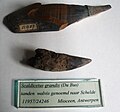Hoseason Island (redirect from Cetacea Rocks)
Named by the UK-APC in 1960 after the zoological order Cetacea (whales and porpoises); these rocks lie in one of the chief Antarctic whaling areas. 63°46′S...
6 KB (828 words) - 15:10, 19 May 2024
Zumberge Capstan Rocks, named after its resemblance to a capstan Catcher Icefall, named for its association with the whaling industry Cetacea Rocks, named after...
25 KB (3,608 words) - 20:08, 22 January 2024
Evolution of cetaceans (redirect from Evolution of cetacea)
present-extending Cenozoic Era. Molecular and morphological analyses suggest Cetacea share a relatively recent closest common ancestor with hippopotami and...
83 KB (9,820 words) - 13:44, 14 August 2024
the water. Raoellids may be the "missing link" sister group to whales (Cetacea). All other Artiodactyla are "cousins" of these two groups. Oxygen-18 values...
7 KB (610 words) - 10:13, 14 August 2024
"Palaeobiological assessment of some basilosauridarchaeocetes (mammalia, cetacea) and its affinity with recent odontocetes: new insights from Wadi El-Hitan...
17 KB (1,907 words) - 01:33, 7 August 2024
O.; Bianucci, G.; de Muizon, C. (2017). "Macroraptorial Sperm Whales (Cetacea, Odontoceti, Physeteroidea) from the Miocene of Peru". Zoological Journal...
14 KB (1,483 words) - 18:47, 6 August 2024
Taiwan, while Pseudorca yokoyamai is found in both Pliocene and Pleistocene rocks in Japan. "Pseudorca yokoyamai Matsumoto 1926 (false killer whale)". fossilworks...
2 KB (103 words) - 21:07, 23 July 2024
million years ago, a common ancestor between the two branched off into cetacea and anthracotheres; anthracotheres became extinct at the end of the Pleistocene...
135 KB (15,060 words) - 13:29, 6 August 2024
of the narwhal, Monodon monoceros, and beluga, Delphinapterus leucas (Cetacea: Monodontidae)". Journal of Anatomy. 233 (4): 421–439. doi:10.1111/joa...
84 KB (8,602 words) - 07:25, 10 August 2024
group's 113.31 km2 (43.75 sq mi), and is surrounded by numerous stacks, rocks and islets like Dent Island, Folly Island (or Folly Islands), Isle de Jeanette-Marie...
32 KB (3,241 words) - 02:32, 6 August 2024
that are in estrus, and rams mark their territories by rubbing scent on rocks. Seven species (and numerous subspecies) of sheep are currently recognized...
10 KB (1,135 words) - 00:06, 26 June 2024
Rochín-Bañaga, H.; Tsai, C.H. (2024). "Echericetus novellus n. gen. n. sp. (Cetacea, Mysticeti, Eomysticetidae), an Oligocene baleen whale from Baja California...
260 KB (27,830 words) - 19:05, 14 August 2024
markers can last for two to three weeks, and are typically placed near rocks, boulders, trees, or the skeletons of large animals. Raised leg urination...
123 KB (13,614 words) - 16:34, 27 July 2024
plotopterids. Its remains can be found in Late Eocene to Late Oligocene rocks from the Makah Formation, the overlying Pysht Formation and the Lincoln...
36 KB (3,630 words) - 03:31, 30 June 2024
hearing. Like the guanacos, they frequently lick calcareous stones and rocks, which are rich in salt, and also drink salt water. Vicuñas are very clean...
22 KB (2,369 words) - 00:49, 15 June 2024
gigantissima nov. gen., nov. sp" [Giant nematoda from the placenta of Cetacea; Placentonema gigantissima nov. gen., nov. sp] (PDF). Doklady Akademii...
162 KB (16,279 words) - 20:17, 4 August 2024
to die out. Archaeological evidence including depictions on pottery and rocks suggests that humped cattle likely imported from the Near East was present...
30 KB (3,022 words) - 22:06, 26 July 2024
cognition. The sea otter uses rocks as essential and regular parts of its foraging behaviour (smashing abalone from rocks or breaking open shells), with...
221 KB (23,065 words) - 04:47, 15 August 2024
"A new species of Middle Miocene sperm whale of the genus Scaldicetus (Cetacea; Physeteridae) from Shiga-mura, Japan". The Island Arc. 3 (4): 453. doi:10...
11 KB (1,099 words) - 02:00, 24 April 2023
2003). "The dinosaurian origin of feathers: perspectives from dolphin (Cetacea) collagen fibers". Naturwissenschaften. 90 (12). Berlin: Springer Science+Business...
284 KB (28,297 words) - 01:11, 9 August 2024
cerebrum or brain. cetology The branch of zoology concerned with the order Cetacea, which includes whales, dolphins, and porpoises. chalcidology The study...
149 KB (778 words) - 04:00, 12 August 2024
or Elephantine Island Mead, J. G.; Brownell, R. L. Jr. (2005). "Order Cetacea". In Wilson, D. E.; Reeder, D. M. (eds.). Mammal Species of the World:...
115 KB (11,448 words) - 19:48, 16 July 2024
Smallest organisms (section Cetaceans (Cetacea))
known bacteria. Nanobes, tiny filamental structures first found in some rocks and sediments, were first described in 1996 by Philippa Uwins of the University...
46 KB (5,146 words) - 19:31, 17 July 2024
Cornelis J.; et al. (2010). "Recent data on whales and dolphins (Mammalia: Cetacea) from the Cape Verde Islands, including records of four taxa new to the...
5 KB (752 words) - 21:18, 4 March 2024
longer, hollow hairs. Mountain goats molt in spring by rubbing against rocks and trees, with the adult billies shedding their extra wool first and the...
20 KB (2,301 words) - 15:23, 19 July 2024
absorb salt and they can be observed licking minerals deposited on cliffs or rocks. Taiwan serows can jump as high as 2 m and run as fast as 55 km per hour...
6 KB (644 words) - 20:07, 27 April 2024
trees interspersed with scrub or pine trees. However, small patches of rocks in farmland or various areas along the Iberian coast also formed suitable...
22 KB (2,732 words) - 09:46, 30 May 2024
†Pseudoceras (Early horse-type ungulate) †Yumaceras hamiltoni (Camel-like) †Cetacea (Whale) †Aepycamelus major (Camel) †Procamelus grandis (Camel) †Hemiauchenia...
14 KB (1,380 words) - 00:53, 17 July 2024
feral dogs and humans. Males are territorial and smear gland secretions on rocks and branches to mark their territories; their preferred resting places are...
5 KB (491 words) - 20:47, 12 May 2024
PMC 4795812. PMID 26268193. Pilleri, Georg (1984). Investigations on Cetacea. Vol. 16–17. Hirnanatomisches Institut der Universität. p. 161. Retrieved...
114 KB (12,000 words) - 00:55, 8 August 2024

























